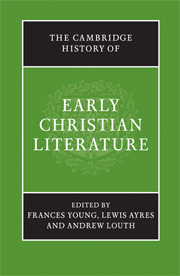Book contents
- Frontmatter
- PART ONE The Beginnings: The New Testament to Irenaeus
- PART TWO THE THIRD CENTURY
- PART THREE FOUNDATION OF A NEW CULTURE: FROM DIOCLETIAN TO CYRIL
- A LITERARY GUIDE
- 21 Classical genres in Christian guise; Christian genres in classical guise
- 22 Arnobius and Lactantius
- 23 Eusebius and the birth of church history
- 24 The fourth-century Alexandrians: Athanasius and Didymus
- 25 Palestine: Cyril of Jerusalem and Epiphanius
- 26 The Cappadocians
- 27 Fourth-century Latin writers: Hilary, Victorinus, Ambrosiaster, Ambrose
- 28 Jerome and Rufinus
- 29 Augustine
- 30 John Chrysostom and the Antiochene School to Theodoret of Cyrrhus
- 31 Cyril of Alexandria
- 32 Hagiography
- 33 Ephrem and the Syriac Tradition
- 34 The literature of the monastic movement
- 35 Women and words: texts by and about women
- 36 Conciliar records and canons
- B CONTEXT AND INTERPRETATION
- Bibliographies
- Index
- Map: The Roman Empire in the late fourth century AD"
- References
26 - The Cappadocians
from A - LITERARY GUIDE
Published online by Cambridge University Press: 28 March 2008
- Frontmatter
- PART ONE The Beginnings: The New Testament to Irenaeus
- PART TWO THE THIRD CENTURY
- PART THREE FOUNDATION OF A NEW CULTURE: FROM DIOCLETIAN TO CYRIL
- A LITERARY GUIDE
- 21 Classical genres in Christian guise; Christian genres in classical guise
- 22 Arnobius and Lactantius
- 23 Eusebius and the birth of church history
- 24 The fourth-century Alexandrians: Athanasius and Didymus
- 25 Palestine: Cyril of Jerusalem and Epiphanius
- 26 The Cappadocians
- 27 Fourth-century Latin writers: Hilary, Victorinus, Ambrosiaster, Ambrose
- 28 Jerome and Rufinus
- 29 Augustine
- 30 John Chrysostom and the Antiochene School to Theodoret of Cyrrhus
- 31 Cyril of Alexandria
- 32 Hagiography
- 33 Ephrem and the Syriac Tradition
- 34 The literature of the monastic movement
- 35 Women and words: texts by and about women
- 36 Conciliar records and canons
- B CONTEXT AND INTERPRETATION
- Bibliographies
- Index
- Map: The Roman Empire in the late fourth century AD"
- References
Summary
The grouping together of Basil of Caesarea, with his friend, Gregory of Naziazus, and his brother, Gregory of Nyssa, as the ‘Cappadocian Fathers’(originally the ‘great Cappadocians’) is a product of modern scholars, who have regarded as significant the family links, geographicallocality andcommon theological commitment they perceived in them. It is not a traditional designation: the three Fathers of the fourth century singled out by the Church as ‘universal teachers’ (οικουμενικoì δiδάσκαλoi) are Basil ‘the Great’, Gregory ‘the Theologian’ (i.e., Nazianzen), and John ‘of the Golden Mouth’ (or Chrysostom), celebrated together on 30 January. We should perhaps pause before linking the ‘Cappadocians’ too closely together: they had individual minds, although the courses of their lives were undoubtedly interwoven.
Basil and his friend, Gregory of Nazianzen, were probably of like age, both born in 329 or 330, the sons of well-off, land-owning families. Their friendship went back to their studies together in Athens in the early 350s. They were both highly accomplished rhetors, skilled in the literary Greek of the classical period. Gregory of Nyssa, Basil’s younger brother, born perhaps in the late 330s, was no less accomplished, though he seems not to have followed him to Athens, but owed his rhetorical training directly to his elder brother. Basil and his friend Gregory were soon drawn to the ascetic life, and in 356, after completing his studies at Athens, Basil went on a tour of monastic settlements in Coele-Syria, Mesopotamia, Palestine and Egypt. On his return he was baptized and retired to his family estate at Annisa in Pontus (near the confluence of the rivers Iris and Lycos) where he joined his mother, Emmelia, and his sister, Macrina, in their life of asceticism. From here he wrote to Gregory Nazianzen, inviting him to join him.
- Type
- Chapter
- Information
- The Cambridge History of Early Christian Literature , pp. 289 - 301Publisher: Cambridge University PressPrint publication year: 2004
References
- 2
- Cited by

